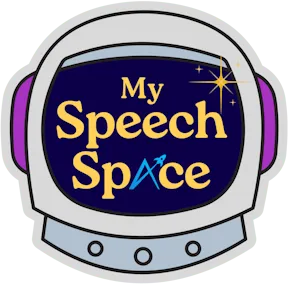
The Power of Gamification in Speech Therapy: Transforming Learning Through Play
Speech therapy demands a delicate balance between clinical expertise and engaging instruction methods. Among the most powerful tools in a modern speech therapist's arsenal is gamification - the strategic integration of game elements into therapeutic activities. By incorporating gaming principles into speech therapy sessions, practitioners can create an environment that not only motivates young clients but also accelerates their progress toward communication goals. My Speech Space was created to create a platform for doing just that! Let's explore the compelling reasons why gamification has become indispensable in speech therapy interventions.
Engagement Through Purposeful Play:
Children are naturally drawn to play, and gamification harnesses this inherent inclination to create meaningful therapeutic experiences. In speech therapy, this principle becomes particularly powerful when addressing challenging speech sounds or language patterns. For example, converting articulation drills into a treasure hunt where each correct pronunciation reveals a clue, or transforming language exercises into an adventure quest can transform potentially frustrating exercises into exciting challenges. These approaches maintain clinical rigor while wrapping therapeutic objectives in layers of enjoyment and discovery.
Multimodal Learning Enhancement:
Speech therapy inherently involves multiple learning pathways, and gamification excellently supports this multifaceted approach. Visual learners benefit from animated demonstrations of correct tongue placement, auditory learners engage with sound-based challenges, and kinesthetic learners thrive through interactive movement-based activities. Gamified platforms can seamlessly integrate these different modalities:
Visual components: Interactive games help to increase motivation and engagement
Auditory elements: Sound effects and verbal rewards
Tactile/kinesthetic aspects: Interactive touchscreen activities or physical movement challenges
Social interaction: Multiplayer options for peer practice and motivation
Motivation Through Progressive Achievement:
Gamification's power lies in its ability to break down complex speech and language goals into manageable, rewarding steps. This systematic approach aligns perfectly with speech therapy's progressive nature. By implementing clear achievement levels, progress tracking, and reward systems, therapists can:
Create customized milestone markers for individual therapy goals
Provide immediate feedback on performance
Celebrate incremental improvements
Maintain detailed progress records through game-based metrics
Foster a growth mindset through visible progression
Digital Literacy and Contemporary Relevance:
In today's technology-driven world, gamification serves a dual purpose: it delivers effective therapy while developing essential digital competencies. Modern speech therapy apps and platforms introduce children to educational technology in a controlled, therapeutic environment. This technological integration:
Facilitates home practice through familiar digital interfaces
Enables remote therapy options when needed
Provides consistent feedback mechanisms
Allows for data collection and progress monitoring
Supports parent involvement through app-based home activities
5. Enhanced Therapeutic Relationships:
Gamification can strengthen the bond between therapist and client. When speech therapists embrace playful, game-based approaches, they create a more relaxed and trusting environment. This enhanced rapport leads to:
Increased session participation
Greater willingness to attempt challenging tasks
Reduced therapy-related anxiety
Improved communication between therapist and child
More productive therapeutic outcomes
Customization for Individual Needs:
Modern gamification platforms offer unprecedented levels of customization, allowing speech therapists to tailor interventions precisely to each child's needs. Therapists can:
Adjust difficulty levels based on individual progress
Modify reward systems to match motivational preferences
Create personalized content focusing on specific speech goals
Incorporate culturally relevant elements
Adapt activities to different age groups and interests
Implementation Strategies for Success To maximize gamification's benefits in speech therapy, consider these practical approaches:
Start with clear therapeutic objectives and design game elements around these goals
Balance entertainment value with clinical effectiveness
Incorporate regular progress monitoring and adjustment mechanisms
Ensure activities are age-appropriate and culturally sensitive
Include options for home practice and parent involvement
Gamification represents more than just a trend in speech therapy - it's a transformative approach that fundamentally reimagines how we deliver speech and language interventions. By thoughtfully implementing game-based strategies, My Speech Space offers speech therapists a platform where they can create a therapeutic environment that not only achieves clinical objectives but also nurtures a child's natural desire to learn and grow. The key lies in understanding that gamification isn't about turning therapy into pure entertainment, but rather about harnessing the powerful motivational and engagement tools that games provide to enhance therapeutic outcomes.
As technology continues to advance and our understanding of learning and motivation deepens, the potential for innovative and impactful interventions grows exponentially. Speech therapists who embrace these developments while maintaining their clinical expertise will be well-positioned to provide increasingly effective, engaging, and personalized therapy experiences. The future of speech therapy lies in this delicate balance between technical innovation and therapeutic wisdom, creating a new paradigm where clinical excellence meets cutting-edge engagement strategies.
Remember: successful gamification in speech therapy requires careful balance - maintaining clinical integrity while maximizing engagement through play. This balance is achieved through thoughtful design, continuous assessment, and adaptation to each child's unique needs and preferences. When implemented with careful consideration of both clinical goals and engagement factors, gamification becomes more than just a tool - it becomes a powerful catalyst for communication development, turning traditional speech therapy into an exciting journey of discovery and growth! Visit MySpeechSpace.com to start your journey!
